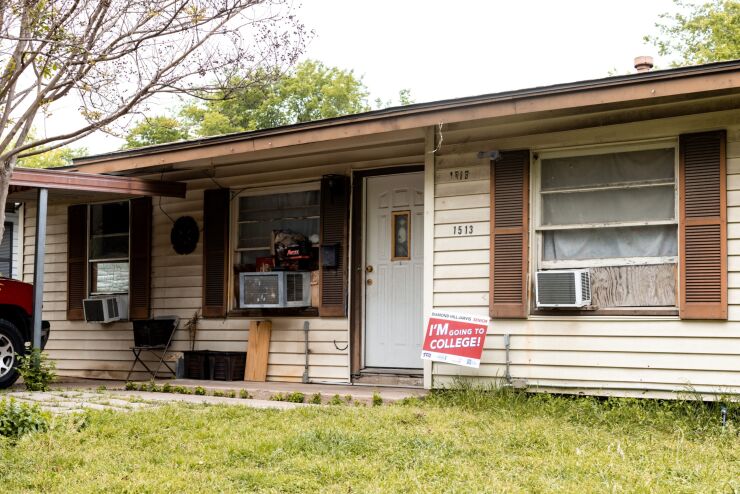(Bloomberg) — It’s hard enough to pay off college loans out of a salary. It doesn’t get any easier when you retire.
The fastest-growing chunk of the U.S.’s $1.7 trillion student-loan pile is the one held by the oldest borrowers. There are now about 8.7 million Americans aged over 50 who are still paying off college loans, and their debt has increased by about half since 2017.
Some took out loans to help their children, and could be well into their 90s before they’re done repaying. Others went back to school later in life. In both cases, borrowers got saddled with hefty interest rates that inflated their balance.
“The interest accrued big-time,” says Alma Topete, 60, who borrowed about $30,000 and owes $70,000 today. “I never expected to have to have a loan at this age.”

That’s why the looming resumption of payments on student loans is a challenge that spans the generations. A pandemic moratorium is due to run out at the end of September, with no progress so far on the debt forgiveness that President Joe Biden promised during his election campaign.
Student loans weren’t supposed to turn into a lifelong burden. The U.S. higher education system, which relies more on individual borrowing than global peers, is premised on the idea that graduates should be able to clear their debt relatively early in their working lives. Most loans come with a 10-year repayment plan, one-third the length of a typical mortgage.
But the reality for many borrowers is very different. Frank Sizer Jr., who’s 77, reckons he has nearly two decades of payments still to go. A former prison warden, Sizer borrowed money to help his son study biology at Bridgewater College in Virginia. He retired in 2010 — two years after his son graduated — and currently owes about $52,000.
“God knows what the original amount was,” he says. “It just continued to grow.” He expected to have paid it off before retiring, and it’s only gotten harder to find the $500 a month for loan payments because “you don’t have the income that you did when you were working.”
One reason why parent borrowers like Sizer often find their loan balances swelling is that they have to pay higher interest rates.
Since mid-2006, federally backed loans under the Parent PLUS program have charged an average of 466 basis points above U.S. Treasury bonds, well above the typical rate for student borrowers. And loans to parents come with a hefty one-time origination fee too. The current going rate is 4.23% of the total amount borrowed — about four times what students are typically charged.
It’s not just parental borrowers who suffer from ballooning loan balances late in life.
For many older Americans, the kind of smooth career path that would’ve allowed them to repay loans on schedule proved unattainable — especially in what’s often been a tough job market since the 2008 financial crisis. Some went back to school to equip themselves with fresh skills, and ended up saddled with new debts instead.
Topete used to be a school-bus driver in Stockton, California, until back-to-back traffic accidents led to debilitating health problems that ultimately put her out of a job.
Her main objective after that, she says, was to go back to school and “learn how to work computers” so she’d be qualified for “more of an office-setting-type job.” As a single parent, she needed the loans to help with everyday bills as well as books and classes.
But now, she says medical issues make it unlikely she can work full-time and earn enough money to ever repay the debt in full. “I just don’t see a way out.”
Unlike many types of debt, there’s no way out of student loans via bankruptcy. Federally-backed ones are dischargeable in death, so they don’t get passed on to loved ones.
Retirees who still owe money can find loan repayments getting deducted from their social security income. In fiscal year 2019, the last full one before the pandemic freeze, the Department of Education recouped $4.9 billion from benefits due under government programs.
That’s helped make student debt a talking point at retirement homes as well as college bars.
In The Villages, for example, a giant age-restricted community in central Florida, the median loan balance rose to $17,921 at the end of 2019, from $11,110 a decade earlier. Before the pandemic forbearance, one in eight borrowers there was severely delinquent, according to the Philadelphia Fed’s Consumer Credit Explorer.
When payments fall due again on Oct. 1, more may struggle to pay. It’s not clear if the government will have taken any steps toward debt writedowns by then.
Biden promised to forgive as much as $10,000 of student loans per borrower. But the president says he’s reluctant to use executive authority to cancel the debt, as some fellow Democrats have urged him to do, and his administration hasn’t outlined an alternative strategy.
Topete, who’s not working right now, says she’s not sure how she’ll manage to make her payments once the COVID-driven-freeze ends. Debt forgiveness would be a “blessing,” and if the administration isn’t going to do that then it should at least change the law so student loans are dischargeable in bankruptcy, she says. “I want to be debt-free going into my retirement.”
Sizer, the retired prison warden, says that he’s “very pessimistic” that loans will be forgiven, but the government should find a way to help reduce interest payments even if it doesn’t write down the principal. He says the U.S. college system is skewed toward those who can afford to send their children through it debt-free.
“Every parent wants their kid to be successful and to get the right start in life,” Sizer says. “If education is as important as everyone makes it out to be — which I agree with — there should be a better way to level the playing field.”





